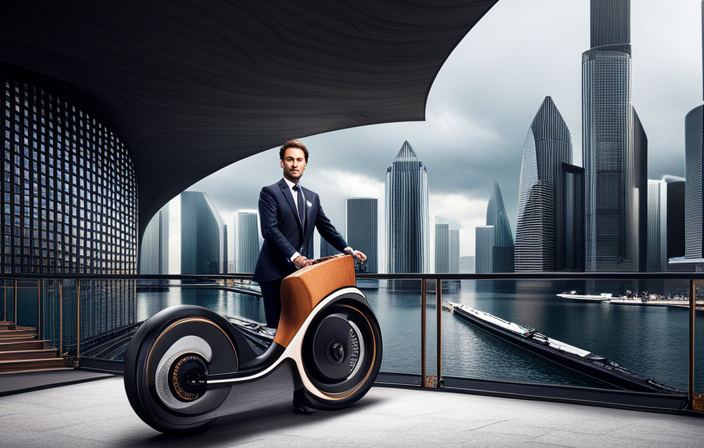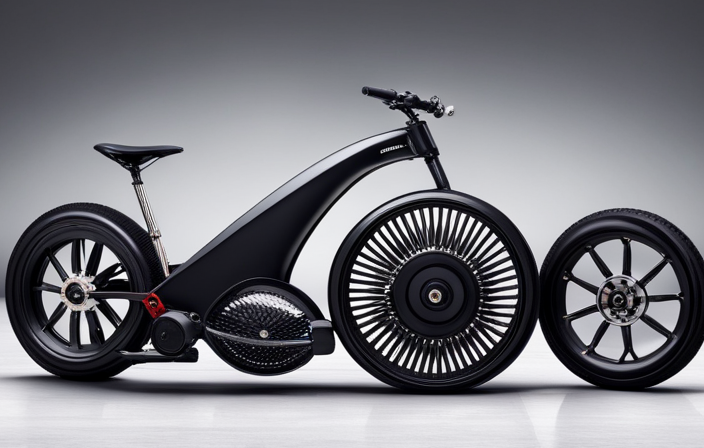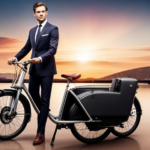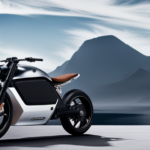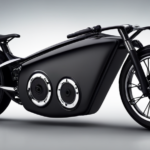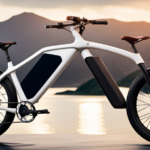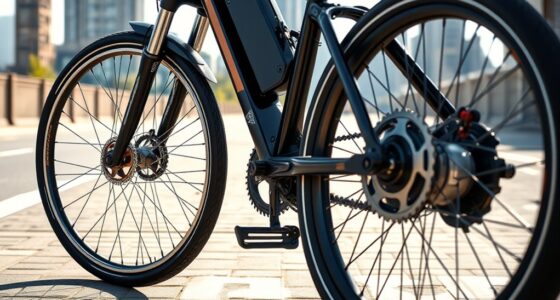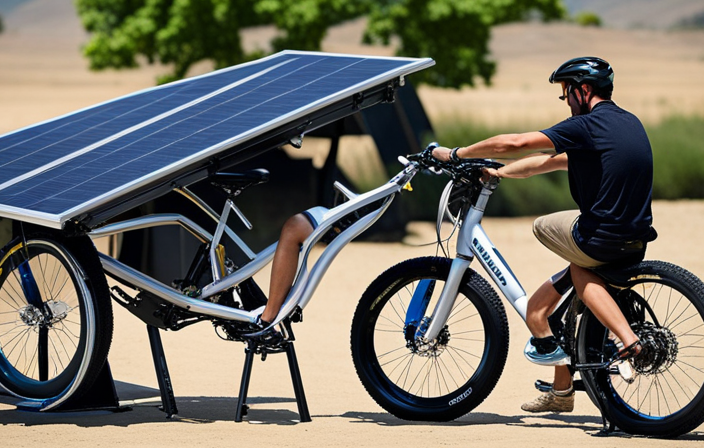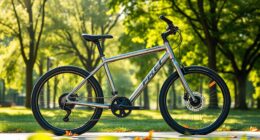As an avid cyclist, I understand the importance of having the right battery size for an electric bike. It’s like having the perfect fuel tank to ensure I can go the distance and conquer any terrain.
In this article, we will delve into the intricacies of determining how big a battery you need for your electric bike. From considering your desired range and riding style to evaluating motor power and efficiency, we will provide you with the technical insights and detailed information you need to make an informed decision.
Key Takeaways
- Calculate the range required based on factors like daily commute and distance.
- Higher wattage motors provide better performance for hilly terrains.
- Battery energy density and its impact on power and size.
- Balancing range, cost, and environmental impact.
Determine Your Desired Range
To determine your desired range, you’ll need to consider how far you plan on riding your electric bike. One of the first steps in determining battery capacity is to calculate the range you require. This involves taking into account factors such as your daily commute or the distance you plan on covering during a ride.
Start by estimating the average distance you typically ride in a day or on a single trip. Consider whether you’ll be using the electric assist mode constantly or only when needed. Take note of any potential detours or additional stops you might make along the way.
Once you have a rough idea of the distance you plan on riding, you can begin to determine the battery capacity you need. Electric bike batteries are usually rated in watt-hours (Wh). To calculate the range, divide the battery capacity by the average power consumption of your electric bike. Keep in mind that power consumption can vary depending on factors such as speed, terrain, and rider weight. It’s always a good idea to add a buffer to your calculations to ensure you have enough battery capacity to cover unexpected circumstances.
Consider the terrain you plan to ride on, as it can significantly impact your range. If you’ll be riding mostly on flat roads or gentle slopes, your battery will go farther. However, if you’ll be tackling steep hills, you’ll need to account for the increased power consumption. Additionally, riding off-road or on rough surfaces can also affect your range.
Consider the Terrain You Plan to Ride On
When considering the terrain you plan to ride on, it’s important to take into account the level of incline and roughness. These factors play a crucial role in determining the right battery capacity for your electric bike.
Here are three key factors to consider when riding on hilly terrain:
-
Gradient: The steepness of the hills you will be encountering is a significant factor in battery capacity selection. Steeper inclines require more power, so it’s important to choose a battery with a higher capacity to ensure you have enough energy to conquer those challenging hills.
-
Distance: Riding on hilly terrain often means longer distances due to the increased effort required. To ensure you have enough power to cover the distance, it’s essential to choose a battery with a larger capacity. This will prevent you from running out of power before reaching your destination.
-
Surface Roughness: Rough terrain can increase the resistance and strain on your electric bike’s motor, which in turn drains the battery faster. If you plan on riding on bumpy or uneven surfaces, it’s advisable to opt for a battery with a higher capacity to handle the extra load.
Considering these factors will help you choose the right battery capacity for different types of terrain. Assessing your riding style and preferences is the next step in finding the perfect electric bike battery for your needs.
Assess Your Riding Style and Preferences
Consider how you prefer to ride and your personal style to determine the best match for your needs. Your riding technique and battery charging options are two important factors to consider when assessing your riding style and preferences.
When it comes to riding techniques, there are various approaches that riders can take. Some riders prefer a more aggressive style, where they push the limits and ride at higher speeds. Others may prefer a more relaxed and leisurely ride, taking their time to enjoy the scenery. Understanding your preferred riding technique is crucial in determining the battery size you will need for your electric bike.
In addition to riding techniques, battery charging options also play a significant role in assessing your riding style and preferences. Different battery charging options offer various advantages and disadvantages. For example, some electric bikes come with removable batteries that can be charged separately, while others require the entire bike to be plugged in for charging. Understanding the charging options available to you will help ensure that your battery is always ready for your next ride.
Now that we have discussed how to assess your riding style and preferences, it is time to evaluate the motor power and efficiency of your electric bike.
Evaluate the Motor Power and Efficiency
Understanding the motor power and efficiency of your e-bike is crucial in determining its performance. When evaluating motor power, it is important to consider the wattage, which directly impacts the speed and acceleration of your electric bike. Higher wattage motors generally provide better performance and are suitable for hilly terrains or off-road riding. On the other hand, lower wattage motors are more suitable for flat terrains or casual city commutes.
Additionally, comparing battery efficiency is essential in assessing the range and longevity of your e-bike. The efficiency of a battery is often measured in watt-hours (Wh) and indicates how much energy the battery can store. A higher watt-hour rating generally means a longer range, allowing you to travel farther on a single charge. It is also important to consider the type of battery, such as lithium-ion, as they tend to be more efficient and have a longer lifespan compared to other battery types.
By evaluating the motor power and comparing battery efficiency, you can ensure that your e-bike meets your specific needs and preferences. This information will help you determine the ideal combination of motor power and battery efficiency for your desired riding style and terrain.
Understanding these factors will allow you to calculate the energy consumption of your electric bike and make informed decisions about battery size and range capabilities.
Calculate the Energy Consumption of Your Electric Bike
To calculate how much energy your e-bike consumes, you can use the formula: motor power (in watts) multiplied by the time of use (in hours) equals energy consumption (in watt-hours). This calculation is essential for determining the energy efficiency of your electric bike and for comparing different battery technologies.
When considering the energy consumption of your e-bike, it is important to keep in mind the following:
-
Battery capacity: The higher the battery capacity, the longer you can ride your e-bike without needing to recharge. This can be particularly beneficial for long-distance rides or when using your e-bike for commuting purposes.
-
Riding style: Aggressive acceleration and constant high speeds can result in higher energy consumption. On the other hand, a more relaxed and steady riding style can help conserve energy.
-
Terrain: Riding on hilly terrain requires more power from the motor, leading to increased energy consumption compared to riding on flat surfaces.
By calculating the energy consumption of your electric bike, you can determine its efficiency and compare it to other e-bike models. This information can guide you in selecting the most suitable battery technology for your needs.
Look for battery options with high energy density, which means they can store a large amount of energy in a compact size. This will allow you to maximize the range of your e-bike while minimizing the weight and size of the battery.
Look for Battery Options with High Energy Density
When searching for battery alternatives, I prioritize options with a high energy density. Energy density refers to the amount of energy that can be stored in a given volume or weight of a battery. This is crucial when it comes to electric bikes because we want to maximize the range without adding unnecessary weight. A battery with a high energy density will provide more power while keeping the weight and size to a minimum.
Battery weight is an important consideration for electric bike owners. The weight of the battery directly affects the overall weight of the bike, which in turn affects its performance and handling. A lighter battery will make the bike easier to maneuver and more agile, especially when navigating through tight spaces or uphill climbs. On the other hand, a heavy battery can make the bike feel sluggish and reduce its range.
Battery price is another factor to consider when choosing a battery for an electric bike. While it may be tempting to opt for a cheaper battery, it’s important to remember that quality and performance should not be compromised. Investing in a higher quality battery may initially cost more, but it will provide better performance, longer lifespan, and more reliable power delivery.
Considering the weight and size of the battery is essential when choosing the right battery for an electric bike. By prioritizing options with a high energy density, we can ensure that the battery provides optimal power without adding unnecessary weight.
Consider the Weight and Size of the Battery
By prioritizing options with a high energy density, you can ensure that the battery provides optimal power without adding unnecessary weight.
When considering the weight and size of the battery for an electric bike, it is crucial to find a balance between power and portability. A heavier battery may provide more energy, but it can also make the bike harder to maneuver and add strain on the frame. On the other hand, a smaller and lighter battery may be more convenient, but it might not offer sufficient power for longer rides.
To determine the ideal battery weight and size, you need to assess your specific needs. Consider factors such as the distance you plan to travel, the terrain you will encounter, and the level of assistance you require from the electric motor. These factors will help you determine the necessary capacity and energy output of the battery. Additionally, you should also factor in the weight of the bike itself and any additional accessories you plan to carry.
Once you have determined the appropriate battery weight and size, you can start exploring different options available on the market. Look for batteries that have a high energy density, meaning they can store a significant amount of energy in a compact size. This will help you maximize the power output while minimizing the physical dimensions of the battery.
Check the Charging Time and Convenience
Check how quickly and easily you can charge the battery to ensure maximum convenience for your electric bike. The charging speed of the battery is an important factor to consider when choosing an electric bike. Look for a battery that can be charged quickly, allowing you to get back on the road in no time.
Additionally, consider the convenience of charging. Does the battery come with a charger that is easy to use and plug in? Can you charge the battery at home or do you need to find a charging station? These are all factors that will affect the overall convenience of charging your electric bike.
Another aspect to consider is the portability and storage of the battery. Is the battery lightweight and easy to carry? Can you easily remove it from the bike for charging or storage purposes? Having a portable battery can make it more convenient to charge and store your electric bike. Additionally, consider the size and shape of the battery. Will it fit comfortably on your bike or do you need to make modifications to accommodate it? These considerations will ensure that you can charge and store your electric bike with ease.
Assessing the battery’s lifespan and durability is essential for maximizing its performance and longevity.
Assess the Battery’s Lifespan and Durability
Assessing the lifespan and durability of the battery is crucial for ensuring its long-lasting performance. When it comes to battery maintenance, understanding how long the battery will last and how well it can withstand daily use is essential. To help you make an informed decision, let’s take a closer look at the factors that contribute to a battery’s lifespan and durability.
| Factor | Importance |
|---|---|
| Battery Chemistry | High |
| Temperature | Medium |
| Depth of Discharge | High |
| Charging Cycles | High |
| Maintenance | Medium |
| Quality of Components | High |
Battery chemistry plays a significant role in determining its longevity. Different chemistries have varying lifespans, with lithium-ion batteries often outlasting other types. Temperature also affects battery performance, as extreme heat or cold can shorten its lifespan. The depth of discharge, or how much energy you typically use before recharging, can also impact the battery’s overall durability. More frequent charging cycles can lead to faster degradation. Proper maintenance, such as regular cleaning and avoiding overcharging, can help extend the battery’s lifespan. Lastly, the quality of components used in the battery construction can greatly influence its durability.
Look for Battery Options with Warranty and Support
When selecting a battery, it’s important to ensure that you choose options that come with warranty and support. This ensures that you will have assistance if any issues arise with your battery. In the market, there are various battery brands available, each offering their own set of features and benefits. With the constant battery technology advancements, it can be overwhelming to choose the right one for your needs. That’s where warranty and support become crucial factors to consider.
Battery brands have different policies when it comes to warranty and support. Some brands offer longer warranties and comprehensive support, while others may provide limited coverage. It’s essential to carefully review the warranty terms and conditions to understand what is covered and for how long. Additionally, consider the availability of customer support channels like phone, email, or live chat to address any concerns or queries you may have.
Considering warranty and support helps in assessing the reliability and trustworthiness of the battery brand. It shows that the manufacturer stands behind their product and is confident in its quality and performance. Having warranty and support also provides peace of mind, knowing that you have recourse if anything goes wrong with your battery. It’s a crucial aspect to consider when making an informed decision about which battery to choose.
Considering the cost and value for money, let’s delve into the next section.
Consider the Cost and Value for Money
It’s important to take into account the cost and overall value you will be getting for your money when considering the battery for your electric bike. Here are some key factors to consider in the Cost vs Performance and Longevity vs Price dilemma:
-
Battery Type: Different battery types have varying costs and performance levels. Lithium-ion batteries are generally more expensive but offer better performance and longer lifespan compared to lead-acid batteries.
-
Capacity: The capacity of the battery determines how far you can travel on a single charge. Higher capacity batteries may cost more but provide better range and longevity.
-
Brand Reputation: Opting for a reputable brand may be more expensive initially, but it often ensures better quality, reliability, and customer support. Investing in a trusted brand can save you money in the long run.
-
Warranty: Consider the length and coverage of the battery warranty. A longer warranty period indicates confidence in the product’s longevity and reliability.
By carefully evaluating cost, performance, longevity, and warranty, you can make an informed decision about the battery that offers the best value for your money.
Once you have considered these factors, it’s time to delve further into researching user reviews and experiences to gain valuable insights into the real-world performance of the battery options available.
Research User Reviews and Experiences
Once you’ve considered the cost and value for money, it’s important to research user reviews and experiences to gain valuable insights into the performance of different battery options. This step is crucial in determining which battery size is the right fit for your electric bike.
There are several research methods you can employ to gather this information. One approach is to browse online forums and communities dedicated to electric bikes. These platforms often feature discussions and reviews from experienced riders who can provide firsthand accounts of their battery performance. Additionally, you can explore e-commerce websites that sell electric bike batteries, as they usually have user reviews and ratings for each product.
When researching user reviews and experiences, it’s essential to consider the pros and cons of each battery option. Look for reviews that highlight the battery’s performance in terms of range, power output, and durability. Pay attention to any common issues or complaints that users may have encountered. This will help you gauge the overall satisfaction level and reliability of each battery option.
Consult with Experts or Electric Bike Enthusiasts
To gain further insights, it’s beneficial to consult with experts or enthusiasts in the field. When it comes to electric bike battery life, understanding the advantages of lithium-ion batteries is crucial.
These batteries have become the standard in the industry due to their numerous benefits. First and foremost, lithium-ion batteries offer a higher energy density, meaning they can store more energy in a smaller and lighter package. This is essential for electric bikes as it allows for longer rides without adding too much weight to the overall bike.
Additionally, lithium-ion batteries have a longer lifespan compared to other battery types, ensuring that your investment will last for years to come. They also have a lower self-discharge rate, meaning they can hold a charge for longer periods of time when not in use. This is particularly useful for those who may not use their electric bikes regularly.
Test Ride Different Electric Bikes with Varying Battery Sizes
When you test ride different electric bikes, you’ll be able to experience the varying battery sizes firsthand. This is an important step in determining the right battery capacity for your needs.
During these test rides, you should pay close attention to the battery life and performance. Here are three key factors to consider when comparing battery sizes:
-
Range: Take note of how far you can ride before the battery runs out. This will give you an idea of the bike’s endurance and whether it aligns with your intended usage.
-
Charging time: Evaluate how long it takes to fully charge the battery. A shorter charging time can be more convenient, especially if you plan to use the bike frequently.
-
Battery weight: Consider the weight of the battery as it can affect the overall weight and maneuverability of the bike. A lighter battery may be preferable if you prioritize agility.
Make an Informed Decision Based on Your Needs and Budget
By considering your needs and budget, you can make an informed decision about which electric bike to choose. When it comes to electric bikes, one of the most important factors to consider is the battery. Not only does the battery dictate how far you can ride on a single charge, but it also affects the overall weight and performance of the bike.
When looking at cost-effective battery options, there are a few key factors to consider. First and foremost, you’ll want to look at the battery capacity, which is measured in watt-hours (Wh). A higher capacity battery will generally allow for a longer range, but it will also be more expensive. It’s important to find a balance between range and cost that suits your needs.
Another important consideration is the environmental impact of different battery choices. Lithium-ion batteries are the most common type used in electric bikes, and they have a relatively low environmental impact compared to other battery chemistries. However, it’s worth noting that the production and disposal of lithium-ion batteries can still have an impact on the environment. If you’re looking for a more environmentally friendly option, you might consider a bike with a removable battery, as this allows for easier recycling and disposal of the battery when it reaches the end of its life.
Frequently Asked Questions
How do I determine my desired range for an electric bike?
To determine my desired range for an electric bike, I need to consider factors such as my daily commuting distance, terrain, desired speed, and battery capacity. By analyzing these factors, I can calculate the ideal battery capacity needed for my electric bike.
What factors should I consider when assessing my riding style and preferences?
When assessing my riding style and preferences, I take into account factors such as terrain, speed, and distance. Riding efficiency is crucial, as it determines how effectively the battery capacity is utilized during my rides.
How can I calculate the energy consumption of my electric bike?
To calculate energy consumption of an electric bike, I need to consider factors such as motor efficiency, weight of the bike and rider, terrain, and average speed. Using these variables, I can determine the battery size needed for optimal performance.
What should I look for in terms of battery lifespan and durability?
When considering battery lifespan and durability, it is crucial to focus on battery capacity and proper battery maintenance. These factors directly impact the overall performance and longevity of the battery, ensuring optimal functionality for an extended period of time.
How do I make an informed decision about the size of the battery based on my needs and budget?
To make an informed decision about battery capacity for an electric bike, I need to consider my needs and budget. I should compare the cost of different battery options and choose one that provides sufficient power and fits within my budget.
Conclusion
Based on the factors discussed in this article, determining the right battery size for your electric bike is crucial for optimal performance and satisfaction. By considering your desired range, the terrain you plan to ride on, your riding style and preferences, as well as the motor power and efficiency, you can calculate the energy consumption and make an informed decision.
For example, if you frequently ride on hilly terrains and have a longer commute, a larger battery capacity would be recommended to ensure you have enough power throughout your ride.
